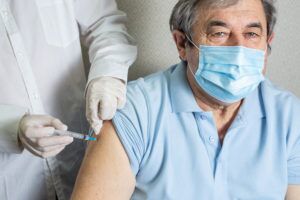Get vaccinated so we can be around people again. That’s been the message from officials and pharmaceutical companies eager to put the pandemic in America’s rearview. The promise of an end to social distancing and isolation has kept many people going through this difficult year.As vaccination rates increase, officials are facing questions on how much and how soon they can open up again. At the forefront of this issue: Nursing homes, which received our nation’s first doses and have fully vaccinated patients and caregivers who want the vaccine. These facilities could provide an example of what a safe re-opening looks like. However, fear of unexpected consequences has put a kibosh on relaxed guidelines—and frustrated many patients.
The Baltimore Sun recently reported on Canadian nursing home patients who, like American patients, were the first recipients of COVID-19 vaccines. Yet, these patients are still being kept inside, in some cases not even allowed to interact with fellow residents. Regulations are patchwork, set by provinces and territories in Canada much like they are set by states and cities in the U.S. The trend, however, is an excess of caution that keeps fully vaccinated patients inside and isolated.
A Continuing Crisis of Isolation
When the coronavirus was spreading unchecked, with no real treatment options and increased risk of serious infection among those who were over 65 or had underlying health conditions, it made sense to lock nursing homes down as much as possible. Now that seniors are largely protected from the virus, advocates are refocusing on the other impacts of the choice: Namely, the danger inherent to loneliness.
A Canadian study on isolation found more than half of nursing home residents have worse cognitive function and emotional health today than they did at the start of the pandemic. Nearly half have also seen physical impacts. There is a real danger, according to a Toronto hospital, that “these people are going to give up” without meaningful activities and interactions to drive their days.
What’s worse, the effects of isolation do not always show up right away. Studies suggest mental decline may not present until two years after a period of isolation begins. Therefore, the true cost of pandemic-era quarantines may not be known until well into 2022.
New Guidelines Needed for a New Reality
The risk of COVID-19 should not be understated—the disease has killed nearly 3,500 Maryland nursing home residents as of late March 2021. However, with the immediate threat fading into the rearview among these populations, it’s time to ensure we’re meeting patients’ other needs. Maybe widespread re-openings aren’t appropriate yet, with only around 15% of Americans fully vaccinated, but changes can be made piecemeal—for example, rules only pertaining to nursing homes and other long-term care facilities.
The responsibility should not rest only with governments, however; nursing homes can do their part as well. For many months, these facilities have focused on prevention at the expense of all else, including general patient wellness. While the strain has surely been great on these facilities, patients are humans with needs as surely as the rest of us. To have all their opportunities for connection, both with the outside world and each other, removed during a time of stress and upheaval was doubly damaging. Especially now that we have a better handle on the pandemic, nursing homes should focus on ways to bring patients together with an eye forward to the next wave of infectious disease.
Can We Get Back What Was Lost?
The pandemic is not yet over, but with the vaccine, much more is possible. Seniors are likely not the only ones who have faced cognitive or physical decline due to isolation (over 6 months during the pandemic, the demand for antipsychotic medication to manage resident dementia increased by 7%). Indeed, even among seniors, isolation is not a new issue.
Scientists studying isolation and mental decline have found promising news that reintroducing social activities may counter the brain changes caused by loneliness. More work must be done to determine how much of an impact ending isolation can have, but we should not wait for answers to re-introduce in-person activities to those who have been vaccinated for COVID-19.
Even if the long-term benefit for brain health remains unknown, having friends and loved ones around us increases our quality of life. That alone is something worth fighting for.
Brown & Barron, LLC handles nursing home neglect and abuse case in Baltimore. Call us for a free consultation at (410) 698-1717.


